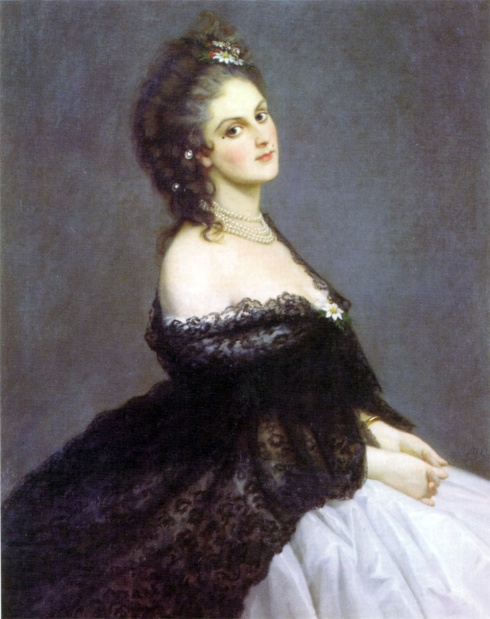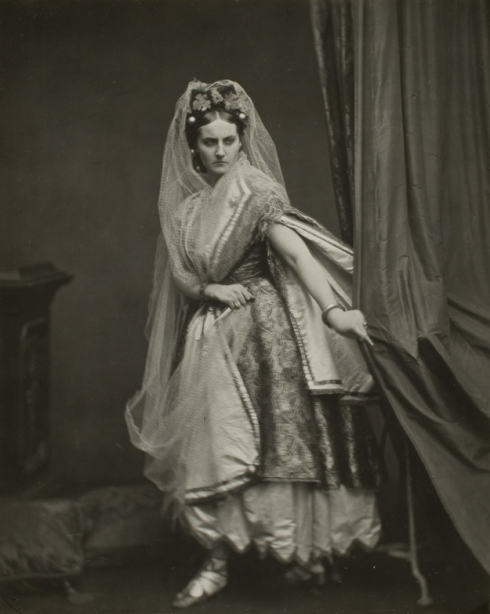A vain and eccentric woman of mystery – Virginia Oldoini, Countess of Castiglione arrived in Paris in 1856, at the peak of Second French Empire. She was a rose of the Second French Empire garden, a rather exotic and extravagant rose that withered too quickly. She shone briefly, like a shooting star, but soon crashed into the darkness of her Place Vendome abode where she spent her last days in rooms without mirrors or daylight, mentally unstable and lonely.
 1863 Photographie de la comtesse de Castiglione
1863 Photographie de la comtesse de Castiglione
La Castiglione, as she was later called, was born on 22 March 1837 in Florence. Her full name is legen (wait-for-it) dary: Virginia Elisabetta Luisa Carlotta Antonietta Teresa Maria Oldoïni. Before she arrived in Paris, La Castiglione was trapped in a loveless marriage to Francesco Verasis, conte di Castiglione, twelve years her senior. She was sent to Paris in 1856 to bolster the interest of Napoleon III in the cause of Italian unification. Her cousin, the minister Camillo Cavour, instructed her to ‘succeed by whatever means you wish—but succeed!‘
Succeeded she did, her beauty and extravagant clothes soon caught the Emperor’s eye, and she became his mistress, but not for long. Their love affair lasted only two years, and in 1857 it was all over. She was determined not to be forgotten nor by the Emperor, nor his poor wife Eugenie de Montijo, nor by the courtiers who were very much amused by the scandals, gossips and intrigues. By then, she was separated from her husband and bankrupted by her glamorous lifestyle. She returned to Italy in self-imposed exile in 1858. But, restless and mischievous as she was, she returned to Paris in 1861 and once again shook up the conventional nineteenth century society.
 1862 Portrait of the Countess di Castiglione painted in Paris by Michele Gordigiani
1862 Portrait of the Countess di Castiglione painted in Paris by Michele Gordigiani
Virginia was famous for her beauty as well as her extravagant lifestyle. Her long, wavy blonde hair, pale skin, and delicate oval face with eyes that constantly changed colour from green to an extraordinary blue-violet must have sparked the Emperor’s imagination when she was first presented at the court on 9 January 1856 at the ball. La Castiglione was two months short of her nineteenth birthday, the Emperor was forty-seven. They expressed their love in June 1856 in Parc de Saint-Cloud; the park that contains one of the most beautiful gardens in Europe: Marie Antoinette’s rose garden, English style garden and Le Notre’s French style garden designed for Louis XIV.
The Princess Metternich described her as having ‘wonderful hair, the waist of a nymph, and a complexion the color of pink marble! In a word, Venus descended from Olympus. Never have I seen beauty to rival hers, not shall I see her like again!‘ In the portrait above, painted in 1862 by Michele Gordigiani, we see La Castiglione at the age of twenty-five, her beauty already fading (the contemporaries have said), but her cheeks are as rosy and fresh as ever, while her eyes radiate confidence, disinterest and a slight coldness.
 1858-62 Virginia Oldoini, Countess of Castiglione
1858-62 Virginia Oldoini, Countess of Castiglione
La Castiglione couldn’t have chosen a better moment to arrive on the scene for the splendor and opulence of Napoleon’s court seem to have been created for her. Second French Empire (1852-1870) was a culturally interesting era in French history. After decades of turmoils and revolutions, the court shone again like it did once before in times of Napoleon Bonaparte. Forty years later, Napoleon III made sure that his reign becomes a synonym for extravagances and opulence. It was in these two decades that many works of art and literature were created: Edouard Manet painted his scandalous masterpieces Olympia and Dejeuner sur l’herbe, Gustave Flaubert published his notorious novel Madame Bovary, and Baudelaire Les Fleurs du Mal – the two literary masterpieces were published the same year (1857), but the latter proved to be a tad too modern for the audience. Haussmann rebuilt Paris, and created all the boulevards, parks and avenues that the Impressionists have later captured on canvas, and which gave the city its current appearance.
 1855 The Empress Eugenie Surrounded by her Ladies in Waiting – Winterhalter
1855 The Empress Eugenie Surrounded by her Ladies in Waiting – Winterhalter
Still, the Napoleon III had a quite conservative taste in art, preferring the works of Franz Xaver Winterhalter and Alexandre Cabanel to decadent and fluttery brush strokes of Manet and Whistler. Winterhalter was a German painter famous for his court portraits such as the portrait of Austrian Empress Elisabeth Sissi. One of his lovely, lovely paintings shows Empress Eugenie and her ladies in waiting. Painted in bucolic, 18th century manner, it displays the opulence and stability of Napoleon III’s reign.
Just like Napoleon Bonaparte’s Josephine, Napoleon III had Eugenie by his side. She faithfully performed her duties as an Empress: organised balls, parties, accompanied the Emperor to the opera, advocated equality for women, and turned her court into a never ending fashion show, instead of Dior or Chanel’s creations, the courtiers admired her dresses made by Charles Frederick Worth, a very popular 19th century designer.
Fashion at the time seems to have been created for the Countess of Castiglione for it is truly the most extravagant period in Victorian fashion. Crinoline was all the rage, and evening dresses were a little masterpieces, in pastel colours with countless flounces, lace decorations, carefully arranged with roses or other flowers. The neckline was open, revealing the shoulders. Sleeves were short and usually puffed but came in variety of shapes; petal, puff, flutter, bell, cap, basic short, gathered, petal and puffed combination, cap and puffed combination.
Neckline was usually decorated with lace, flower bouquets, jewels or single flowers; roses were quite popular. Little bouquets were often asymmetrically placed on the skirt. Most used fabrics were silk, taffeta, moire, organdie, muslin, tulle and lightweight brocade. Dresses created by Charles Frederick Worth were known for their lavish fabrics and trimmings and for incorporating elements from period dress. He was the dream of every Victorian woman and his individualistic approach gained him many faithful customers.
Upon arriving to Paris the second time, in 1861, the Countess of Castiglione transformed herself into a mysterious femme fatale and formed numerous liaisons with notable aristocrats, financiers, and politicians. She is said to have charged a member of the British aristocracy one million francs for 12 hours in her company. All she had was beauty, and when it faded, the her admirers and lovers abandoned her.
La Castiglione was almost pathologically vain and narcissistic. Not only did she arrange photo shoots with a prominent Parisian photographer Pierre-Louis Pierson, but she also sent her friends photo albums filled with photos of her in different poses and dresses. Today, in ‘era of selfies’, this doesn’t seem like a big deal, but back then it was considered almost deranged. Her sessions with Pierson produced more than 400 photos that were created in three specific periods: her glorious first years in French society, 1856-57; her reentry into Parisian life, from 1861 to 1867; and toward the end of her life, from 1893 to 1895.
 1862 Virginia Oldoini, Countess de Castiglione
1862 Virginia Oldoini, Countess de Castiglione
In the photos, La Castiglione is seen wearing extravagant and luxurious dresses, in different poses and face expressions. Not only did she pose as her glorious self, but she also transformed herself into many different characters from The Queen of Hearts, Medea, and Nun, to exotic Queen of Etruria.
The Queen of Heart is probably her most interesting costume. The photo shows La Castiglione dressed in the very same costumes that she wore on a costume ball years earlier. It was the ball held on 17 February 1857 in honour of Ministry of foreign affairs. The splendid ball had an aura of nostalgia for the Marie Antoinette and Petit Trianon, peaceful days before the revolution. Also, Empress Eugenie was a big fan of the 18th century and she adored Marie Antoinette, even dressed like her on one occasion. As always, La Castiglione outshone everyone on the ball when she arrived wearing her ‘heart dress’.
”The Countess is not lavish of herself. She seldom appears in society. Whenever she does so it is an event. Behold her entering the salons of the Ministry of Foreign Affairs in the middle of the ___ She is dressed as the queen of hearts, a symbolic costume, for it is an allusion to the innumerable hearts which the Countess “draws after her,” as
Racine would have said. On her head glitters a crown formed of hearts. Her marvellous hair ripples around her forehead and falls in cascades on her neck. Her skirts and corsage are laced with chains composed of hearts. Her train is caught up on the hip. ‘Tis a bewitching costume.’‘(source)
 1863. La comtesse de Castiglione en Dame de Cœur vers, par Pierre-Louis Pierson à Paris
1863. La comtesse de Castiglione en Dame de Cœur vers, par Pierre-Louis Pierson à Paris
”As to the Countess, she carried the weight of her beauty insolently. The proud Countess does not wear corsets ; she would willingly be a model to a Phidias, if there were one, and she would pose clad only in her beauty. La Castiglione is a courtesan like Aspasia ; she is proud of her beauty and she veils it only as much as is necessary to be admitted into a drawing-room.”




 1861-67. Dress that belonged to the Comptesse De Castiglione
1861-67. Dress that belonged to the Comptesse De Castiglione
La Castiglione was a true demimondaine. With her extravagant lifestyle, hedonism, dependance on lovers, unusual demands, theatrical life choices she fully embodies the term demi-monde which was commonly used in the 19th and early 20th century Europe. According to the dictionary the meanings of this word are ‘(in 19th-century France) a class of women considered to be of doubtful social standing and morality‘ and ‘a group of people on the fringes of respectable society.‘
As most demimondaines, La Castiglione ended up as a victim of her own lifestyle. She spent all her money, she lacked charms and her beauty faded. In the last years of life, after the fall of the Second Empire in 1870, she lived a reclusive and eccentric life in the Place Vendome. She decorated her abode with black curtains which hid her from daylight. She smashed the mirrors for they revealed her true age and looks, a face that was once beautiful but isn’t anymore. Furthermore, she left her flat only at night when she wondered the streets of Belle Epoque Paris shrouded in a long black veil. We can draw paralells between La Castiglione’s lifestyle and photo shoots and those of Luisa Casati, an eccentric Italian heiress, muse, and patroness of the arts in the early 20th century.
 1893 La comtesse de Castiglione, enveloppée de voile et châle en crepe noirs
1893 La comtesse de Castiglione, enveloppée de voile et châle en crepe noirs
Her final photos show the mental instability that led her lead that kind of lifestyle. She still dreamt of having her photos shown at the Exposition Universelle of 1900 in a retrospective titled ‘The Most Beautiful Woman of the Century‘. This never happened and she died on 28 November 1899 at the age of sixty-two. Her life caused admiration and curiosity among the aesthetes of fin-de-siècle Paris. Among them was Robert de Montesquiou, a symbolist poet and a dandy, who spent thirteen years writing her biography La Divine Comtesse. It is also said that he was the inspiration for the character Jean des Esseintes in Joris-Karl Huysmans’ novel A Rebours (Against the Nature) and for the Baron de Charlus in Proust’s In Search of Lost Time.






